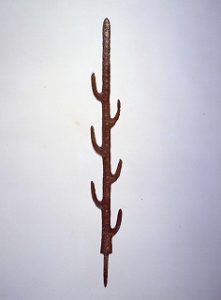国宝「七支刀(しちしとう)」の新たなる発見(愛知県名古屋市千種区姫池通 骨董買取 古美術風光舎)
2025.05.22
少々大袈裟かもしれませんが、この時代に生まれてきてよかったな…と思うことが一つあるのですが笑。それは昨今の分析技術のお陰でこれまでだと謎とされてきたことが解明される瞬間であります。折しも先日訪れた奈良国立博物館「超国宝展」にて展示されておりました石上神宮の「七支刀(しちしとう)」のニュースが上がっておりました。
古墳時代に朝鮮半島から伝わったとされる石上神宮の国宝「七支刀(しちしとう)」ですが、奈良国立博物館が最新の分析装置での調査結果では、内部はほとんど腐食しておらず、極めて良好な状態が保たれていることがわかったそうです。1600年前の剣としては状態が非常によく奇跡的だとのことです。
先日実際にみてきたのですが、表面は赤褐色にさびていました。再び磨ぐとあの中からきらりと光る鋼が現れるのでしょうか。

先日も簡単にご説明しましたが、この国宝「七支刀」左右に3本ずつ枝分かれした刃が突き出す独特の形をした鉄の剣でして、1600年ほど前の古墳時代に朝鮮半島から当時の日本に伝わったとされています。奈良県天理市の石上神宮が所蔵しているのですが、今回、七支刀などを展示する展覧会が開かれるのに合わせて保存状態などを確認しようと、奈良国立博物館がX線を使った最新の分析装置で調査していたようです。
鋼の状態も良好であったのですが、さらに初めてのX線CT(コンピューター断層撮影)の調査において、七支刀の両面に彫られている金象眼の銘文が、今回くっきりと浮かび上がってきました。不明瞭だった文字の一部が鮮明になり、日本の古代史を知る貴重な手がかりとなる銘文の研究がいっそう進むことが期待されるようです。
その銘文はと言いますと
(表面) 泰□四年(□□)月十六日丙午正陽造百練釦七支刀□辟百兵供供侯王□□□□作
(裏面) 先世以来未有此刀百済□世□奇生聖音故爲倭王旨造□□□世
となっているのですが、今回の調査では、別の文字とする説もあった百済の「済」の字が鮮明に写っていたとのこと。さらに、多くの研究者が中国の元号「泰和(=太和)四年」(369年)と読んできた七支刀の制作年は、「和」の残りが悪いため、「泰始四年」(468年)とする説もあったのですが、今回、象眼が脱落した「のぎへん」の痕跡がより明確に見えたことから「泰和」の可能性がさらに高まってきました。過去にも七支刀はX線写真が撮られたことがあるようなのですが、両面の銘文が重なって文字が読みづらかったようでして、今回のCTは対象をスライス状に撮影するため表と裏の銘文を別の画像で読むことができたようです。
また製法を巡っても、鉄素材をたたき延ばす鍛造だったのか、鋳型に溶けた鉄を流して成型する鋳造だったのかが議論になっているようですが、今回のCT画像からは剣身に枝刃を後からつなぎ合わせた痕跡は認められなかったのですが、鍛造か鋳造かの判断は専門家を交えて詳細に検討する必要があるようですね。
実際に拝見するとこの錆び方は大丈夫なのか…などと心配になってしまいそうですが、調査では深刻な劣化や亀裂などは見つからなかったようでして、今回の健康診断は良好のようでした。
まだすべての銘文解読とは至ってはいませんが、一文字でもわかったことは、時代の謎解きの途中に立ち会ちあったような気がして、ちょっとうれしいものでもありますね。
それではごきげんよう。(スタッフY)
It may be a bit exaggerated, but there is one thing that makes me glad to have been born in this era… lol. It is the moment when something that has been considered a mystery until now is clarified thanks to the recent analytical technology. The other day, I visited the Nara National Museum and saw the news about the “Shichishito,” a seven-sided sword from Ishigami Jingu Shrine, which was on display at the “Super National Treasure Exhibition.
According to the Nara National Museum’s latest analytical equipment, the interior of the sword is almost completely uncorroded and remains in excellent condition. I saw the sword in person the other day.
I actually saw it the other day, and its surface was rusted to a reddish-brown color. I wondered if the shiny steel would appear from the surface when the sword was polished again.
As I briefly explained the other day, this National Treasure “Shichishito” is an iron sword with a unique shape with three branching blades protruding from each side, and is said to have been introduced to Japan from the Korean Peninsula during the Kofun period about 1,600 years ago. The sword is in the possession of Ishigami Jingu Shrine in Tenri City, Nara Prefecture, and the Nara National Museum has been examining it with the latest analytical equipment using X-rays in order to check its state of preservation in conjunction with an exhibition to be held this time to display the Seven Swords and other items.
The steel was in good condition, but the first X-ray CT (computed tomography) survey revealed that the gold inlays engraved on both sides of the sword were clearly visible. This clarification of some of the previously unclear characters is expected to further advance research on the inscriptions, which provide valuable clues to understanding Japan’s ancient history.
The inscription is as follows
(Front side) 16th day of the 4th month of the 4th year of the Heigo period in the year Taiyo (□□), made by Houou, a hundred knives, seven zodiac buttons and a fed-up hundred soldiers. □□□□
(Reverse side) Since the previous generation, this sword has never been made by a king of Japan.
The current research clearly shows the Chinese character for “Je” in “Baekje,” which some have suggested was a different character. Furthermore, the year of the production of the seven scrolls, which many researchers have read as the fourth year of the Chinese era “Taihe (=Taihe)” (369), was also believed to be the fourth year of ‘Taishi’ (468) because of the poor “Wa” remainder. This time, the possibility of “Tai Wa” has become even more likely, as traces of the “nogi-hen” with its missing inlays were more clearly visible.
It seems that the Nanashito has been X-rayed in the past, but the inscriptions on both sides overlapped, making it difficult to read the characters, and this time, since the CT was used to slice the object, the inscriptions on the front and back could be read in different images.
There is a debate over whether the sword was forged by beating the iron material or casted by pouring molten iron into a mold. However, it seems that a detailed examination with a specialist is necessary to determine whether the sword was forged or cast.
When we actually see it, we might be concerned about the rusting…etc. However, no serious deterioration or cracks were found in this investigation, and the physical examination seemed to be good this time.
Although we have not yet been able to decipher all of the inscriptions, we are happy to have learned even a single letter, as if we were there in the middle of solving a mystery of the times.
Have a good day. (Staff Y)
*****************
ご実家の整理やお片付けなどをされている方のご相談などが多くございます。
お片付けなどくれぐれもご無理のないようになさってくださいませ。
風光舎では古美術品や骨董品の他にも絵画や宝石、趣味のお品など様々なジャンルのものを買受しております。
お片付けをされていて、こういうものでもいいのかしらと迷われているものでも、どうぞお気軽にご相談下さいませ。
また風光舎は、出張買取も強化しております。ご近所はもちろん、愛知県内、岐阜県、三重県その他の県へも出張いたします。
まずは、お電話お待ちしております。
なお、毎月21日の持込鑑定会では無料鑑定・買取・持込など、ご予約なしで承っております。
ご近所の皆さま、ご遠方のみなさまも、お気軽にお越しくださいませ。
愛知県名古屋市千種区姫池通
骨董 買取【古美術 風光舎 名古屋店】
TEL052(734)8444
10:00-18:00 OPEN
#出張買取#骨董#古美術#骨董品#絵画#版画#茶道具#刀剣#彫刻

